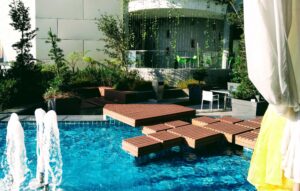Creating a perfect oasis for relaxation and entertainment, swimming pools add a touch of luxury and serenity to any property. Whether you are planning an outdoor retreat or an indoor escape, incorporating additional pool equipment and considering essential design aspects will significantly enhance your swimming experience. In this blog, we will explore the various additional equipment options available and discuss key considerations for designing outdoor and indoor pools.

1.Outdoor Pool Equipment:
a) Pool Heaters – Extend your swimming season and maximize comfort by investing in a pool heater. Gas, electric, or solar heaters can maintain ideal water temperatures even during cooler months, allowing you to enjoy your pool year-round.
b) Pool Covers – Keep maintenance low and protect your pool from debris with a durable pool cover. Covers can also prevent heat loss, reduce water evaporation, and enhance safety.
c) Lighting – Illuminate your pool area with stylish underwater and landscape lighting for extended evening enjoyment. Not only do lights create a magical ambiance, but they also enhance safety and visibility at night.

2. Indoor Pool Equipment:
a) Ventilation System – Adequate air circulation is crucial for both user comfort and protecting the surrounding indoor space from excess moisture. Installing a professional-grade ventilation system ensures fresh air supply, reduces condensation, and prevents mold and mildew growth.
b) Dehumidifiers – Indoor pools require efficient dehumidification systems to minimize moisture buildup. Implementing dehumidifiers helps maintain a comfortable swimming environment, prevents structural damage, and improves air quality.
c) Automatic Pool Covers – In an indoor setting, automatic pool covers simplify pool maintenance, retain heat, and provide additional safety benefits. They also help regulate humidity levels by minimizing evaporation.

Key Points for Outdoor and Indoor :
- Size and Shape – Consider the available space and purpose of your pool to determine the ideal size and shape. Take into account the surroundings, aesthetics, and intended activities.
- Accessibility and Safety – Incorporate safety features such as non-slip surfaces, pool alarms, and fencing. Ensure easy access with steps, handrails, or a sloping entry for individuals with disabilities or limited mobility.
- Landscaping and Ambiance – Enhance the pool area with well-planned landscaping, including plants, trees, and privacy features. Select appropriate materials like slip-resistant decks and durable pool finishes to create a harmonious atmosphere.
- Water Treatment and Filtration – Maintain crystal-clear water by investing in a reliable filtration system and effective water treatments. Consider alternatives such as saltwater systems or UV sanitizers for eco-friendly options.
- Entertaining Areas – Designate space for outdoor seating, dining areas, or sunbathing spots to complement the pool area and enhance social gatherings.
- Privacy and Shade – Incorporate features like pergolas, umbrellas, or privacy screens to offer shade and seclusion when desired.

Conclusion:
Incorporating additional pool equipment and considering important design points are crucial for creating a functional, safe, and enjoyable outdoor or indoor pool. From filtration systems and water treatment to heating and cooling options, each aspect plays a significant role in maintaining water quality, temperature control, and overall pool longevity. Additionally, safety features and proper lighting contribute to a welcoming and secure swimming environment.










